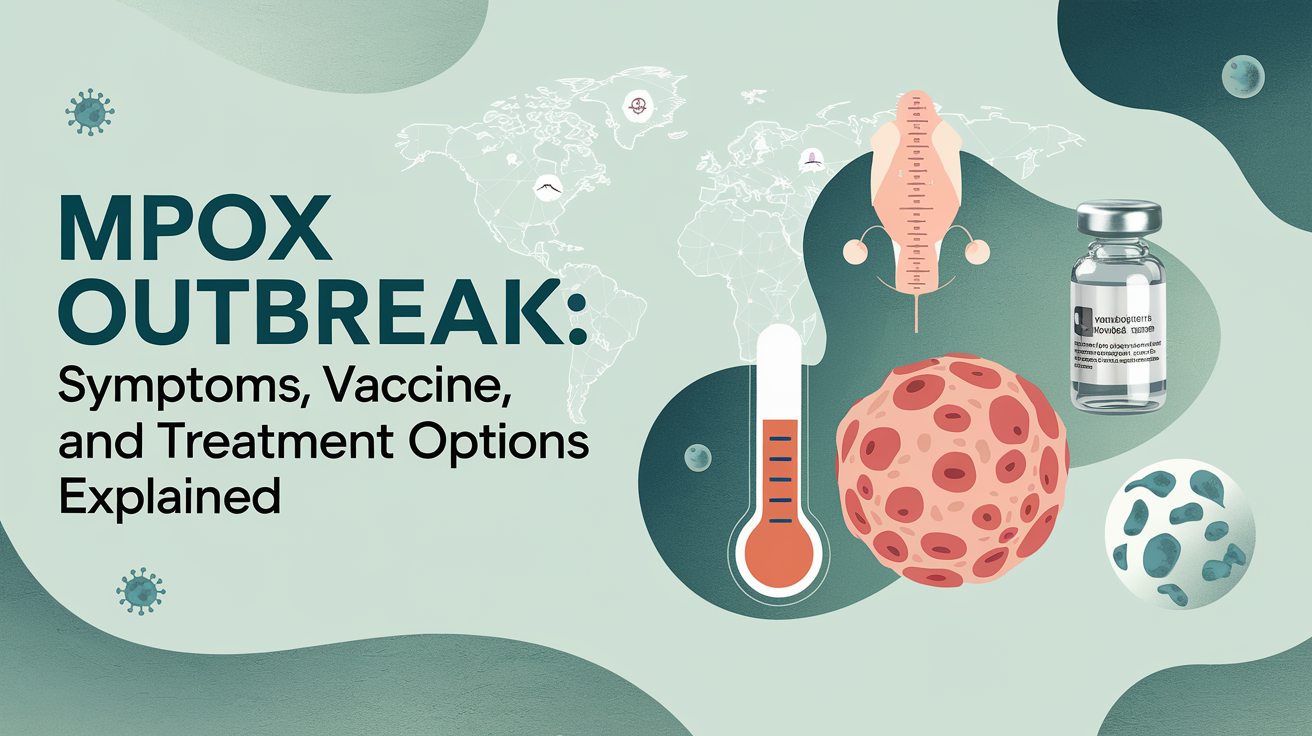Mpox Outbreak: Symptoms, Vaccine Rollout, and Treatment Breakthroughs
The Mpox outbreak, formerly known as monkeypox, has become a significant global health concern as cases rise worldwide. This comprehensive guide explores every aspect of Mpox, from its symptoms and causes to diagnosis, management, and treatment options. It also provides essential information on prevention strategies and living with the disease.
Overview
What is Mpox?
Mpox, previously referred to as monkeypox, is a rare viral disease caused by the Mpox virus, part of the Orthopoxvirus genus. This genus includes the smallpox virus, which was eradicated in 1980. Mpox primarily affects regions in Africa but has been increasingly reported globally.
- Virus Clades: Mpox virus has two main clades:
- Clade I: Originates from Central Africa and is generally more severe.
- Clade II: Originates from West Africa and is less severe, with the current outbreak associated with Clade IIb.
Understanding Mpox’s historical context and virus classification is crucial for tracking its spread and managing the outbreak effectively.
Symptoms and Causes
Mpox Symptoms
The symptoms of Mpox typically develop within 5 to 21 days after exposure to the virus. Key symptoms include:
- Fever: Often the initial sign, accompanied by chills and body aches.
- Rash: Starts as flat red bumps that evolve into painful blisters filled with pus. The rash appears on various body parts, including the face, hands, feet, and genital area. The progression includes crusting over, lasting two to four weeks.
- Swollen Lymph Nodes: A distinguishing feature of Mpox, differentiating it from other pox diseases.
- Additional Symptoms: Headache, muscle aches, fatigue, and chills.
How Mpox Spreads
Mpox is transmitted through:
- Person-to-Person Contact: Spread via sores, scabs, respiratory droplets, or oral fluids, especially through close physical contact such as hugging, kissing, or sexual activities.
- Animal-to-Person Transmission: Through bites, scratches, or contact with an infected animal’s blood or bodily fluids.
- Contaminated Materials: Contact with contaminated clothing, bedding, or other materials used by infected individuals or animals.
Diagnosis and Tests
How is Mpox Diagnosed?
Diagnosing Mpox involves:
- Clinical Evaluation: Initial assessment based on symptoms and exposure history.
- Laboratory Tests: Includes a tissue sample from an open sore tested via polymerase chain reaction (PCR) for genetic identification of the virus. Blood tests may also be used to detect the virus or antibodies.
Healthcare providers use these diagnostic tools to differentiate Mpox from other similar diseases, such as measles or chickenpox, by its unique rash and swollen lymph nodes.
Management and Treatment
Is There a Cure for Mpox?
Mpox is usually self-limiting, and there is no specific antiviral treatment approved exclusively for the disease. Management focuses on:
- Symptom Relief: Pain relievers like ibuprofen or acetaminophen can help with fever and discomfort. Oatmeal baths may soothe the rash.
- Antiviral Drugs: In severe cases, drugs such as cidofovir or tecovirimat may be used. These drugs, approved for other viral infections, are still being studied for their effectiveness against Mpox.
- Secondary Infections: Antibiotics may be required if secondary bacterial infections develop.
Supportive care includes hydration, monitoring symptoms, and managing any complications.
Prevention
How Can Mpox Be Prevented?
Preventing Mpox involves:
- Vaccination: Smallpox vaccines offer protection against Mpox and are recommended for individuals at high risk of exposure.
- Avoiding Contact: Stay away from infected animals and people, and avoid contaminated materials.
- Hygiene: Frequent handwashing, using personal protective equipment (PPE), and avoiding close contact with infected individuals can reduce transmission.
- Safe Practices: Use condoms and dental dams during sexual activities, and wear masks in crowded settings.
Outlook / Prognosis
What is the Prognosis for Mpox?
Mpox generally resolves within two to four weeks. Most individuals recover without complications. However, in rare cases, the disease can be severe or fatal. Potential complications include:
- Pneumonia: An infection of the lungs.
- Encephalitis: Inflammation of the brain.
- Eye Infections: Affecting vision.
Early diagnosis and supportive care improve the prognosis and reduce the risk of severe outcomes.
Living With Mpox
How Should You Manage Life with Mpox?
If infected with Mpox:
- Isolation: Avoid contact with others until all lesions have scabbed over to prevent spreading the virus.
- Symptom Relief: Use over-the-counter medications for pain and fever, and consider oatmeal baths for skin discomfort.
- Careful Hygiene: Wash hands frequently, cover sores, and avoid contact with pets, particularly rodents.
When to Seek Medical Care
Consult a healthcare provider if you:
- Develop Symptoms: Fever, rash, or swollen lymph nodes.
- Have Exposure History: Recent close contact with an infected person.
Emergency Care: Seek immediate medical attention if experiencing severe symptoms such as difficulty breathing, chest pain, confusion, or seizures.
Additional Common Questions
Why Has the Disease Name Changed from Monkeypox?
The World Health Organization (WHO) renamed monkeypox to Mpox in November 2022 to avoid stigma and improve public understanding.
Mpox vs. Chickenpox
- Mpox: Caused by an orthopoxvirus, characterized by a rash with swollen lymph nodes.
- Chickenpox: Caused by a herpesvirus, highly contagious with a rash that appears in waves.
Mpox vs. Smallpox
- Mpox: A related but distinct virus within the Orthopoxvirus genus, with milder symptoms compared to smallpox.
- Smallpox: Eradicated in 1980, historically more contagious and severe.
Understanding Mpox and staying informed about its symptoms, prevention methods, and treatment options are vital for managing and controlling the outbreak effectively.
Mpox Cases Rise: Where the Outbreak is Spreading
Historically, Mpox was primarily reported in Africa, with isolated cases in other regions. However, recent years have seen a significant increase in global cases:
- Historical Context: Mpox was once confined to Central and West Africa, with sporadic outbreaks occurring in these regions.
- Recent Outbreaks: The outbreak gained global attention in 2021 when a case was reported in the United States following travel from Nigeria. By 2022, Mpox outbreaks had spread to Europe, the Americas, and Australia. This global spread highlights the increasing prevalence of Mpox and the need for international surveillance and response.
The rise in Mpox cases outside Africa underscores the importance of monitoring and preventive measures to control the spread of the disease.
Mpox Vaccine Rollout: Protecting Against the Outbreak
Vaccination plays a crucial role in managing the Mpox outbreak. Smallpox vaccines, which eradicated smallpox, also provide protection against Mpox. The current vaccine rollout focuses on individuals at higher risk of exposure:
- Target Groups:
- Close Contacts: People who have had direct physical contact with someone diagnosed with Mpox.
- Sexual Partners: Those who have had recent sexual contact with an infected person or engaged in high-risk sexual behaviors.
- Healthcare Workers: Individuals working in environments where they may be exposed to Mpox or its contaminated materials.
- Vaccination Strategy: The vaccine is recommended for those in high-risk categories to prevent infection. Consulting with a healthcare provider can help determine if vaccination is necessary and discuss concerns about vaccine administration.
The effectiveness of vaccination in preventing Mpox and controlling outbreaks relies on timely and targeted vaccination efforts.
Mpox Treatment Breakthroughs: Managing and Treating the Disease
Currently, there are no specific antiviral treatments approved exclusively for Mpox. Management focuses on supportive care and symptom relief:
- Supportive Care:
- Symptom Relief: Over-the-counter medications like ibuprofen or acetaminophen can help manage pain and fever. Oatmeal baths may soothe itching associated with the rash.
- Hydration and Monitoring: Maintaining hydration and monitoring for complications are essential parts of care.
- Antiviral Drugs: In severe cases, antiviral drugs such as cidofovir or tecovirimat may be used. These drugs are approved for treating smallpox, and their effectiveness for Mpox is under investigation. Researchers continue to explore treatment options to improve outcomes for Mpox patients.
- Secondary Infections: Antibiotics may be prescribed if secondary bacterial infections occur, complicating the Mpox illness.
Effective management and treatment of Mpox require ongoing research and a multi-faceted approach to care.
Mpox Alert: Staying Safe and Informed Amidst the Outbreak
Preventive measures are vital in controlling Mpox and reducing transmission:
- Avoiding Contact:
- Infected Individuals: Avoid close contact with people showing symptoms of Mpox.
- Contaminated Materials: Stay away from materials like bedding or clothing that may be contaminated with the virus.
- Hygiene Practices:
- Hand Washing: Frequent handwashing with soap and water helps prevent the spread of the virus.
- Personal Protective Equipment (PPE): Use PPE if caring for someone with Mpox to reduce the risk of transmission.
- Safe Sex Practices: Use condoms and dental dams to lower the risk of transmission during sexual activities.
- Face Masks and Disinfection: Wearing masks in crowded spaces and cleaning frequently touched surfaces help minimize the risk of airborne and surface transmission.
If symptoms of Mpox develop or exposure is suspected, seeking medical attention promptly is crucial for effective management and to prevent further spread of the disease.
Conclusion
The Mpox outbreak highlights the need for continued vigilance and proactive measures. Understanding Mpox symptoms, participating in vaccination programs if at risk, and following preventive strategies are essential to managing and controlling the spread of this disease. By staying informed and adhering to public health guidelines, individuals and communities can better protect themselves from Mpox and mitigate its impact.
Source: Cleveland Clinic

